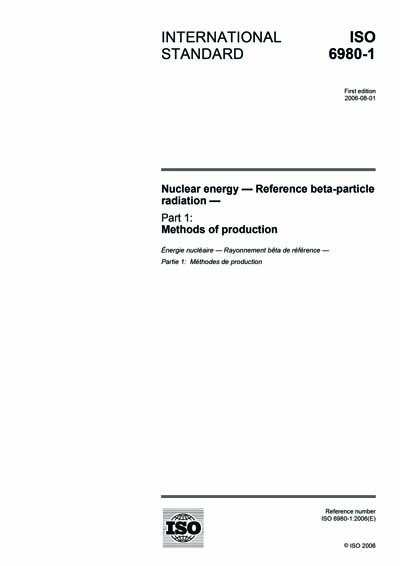Historical
ISO 6980-1:2006
Nuclear energy - Reference beta-particle radiation - Part 1: Methods of production
ISO 6980-1:2006 specifies the requirements for reference beta radiation fields produced by radionuclide sources to be used for the calibration of personal and area dosimeters and dose-rate meters to be used for the determination of the quantities Hp(0,07) and H'(0,07), and for the determination of their response as a function of beta particle energy and angle of incidence. It gives the characteristics of radionuclides that have been used to produce reference beta radiation fields, gives examples of suitable source constructions and describes methods for the measurement of the residual maximum beta particle energy and the dose equivalent rate at a depth of 0,07 mm in the International Commission on Radiation Units and Measurements (ICRU) sphere. The energy range involved lies between 66 keV) and 3,6 MeV and the dose equivalent rates are in the range from about 10-5Sv h-1 to at least 10 Sv h-1. In addition, for some sources variations of the dose equivalent rate as a function of the angle of incidence are given.
ISO 6980-1:2006 proposes two series of beta reference radiation fields from which the radiation necessary for determining the characteristics (calibration and energy and angular dependence of response) of an instrument can be selected.
Series 1 reference radiation fields are produced by radionuclide sources used with beam flattening filters designed to give uniform dose equivalent rates over a large area at a specified distance. The proposed sources of 90Sr + 90Y, 85Kr, 204Tl and 147Pm produce maximum dose equivalent rates of approximately 200 mSv h-1.
Series 2 reference radiation fields are produced without the use of beam-flattening filters, which allows large area planar sources and a range of source-to-calibration plane distances to be used. Close to the sources, only relatively small areas of uniform dose rate are produced but this series has the advantage of extending the energy and dose rate ranges beyond those of series 1. The radionuclides used are those of series 1 with the addition of the radionuclides 14C and 106Ru + 106Rh; these sources produce dose equivalent rates of up to 10 Sv h-1.
Content Provider
International Organization for Standardization [iso]






